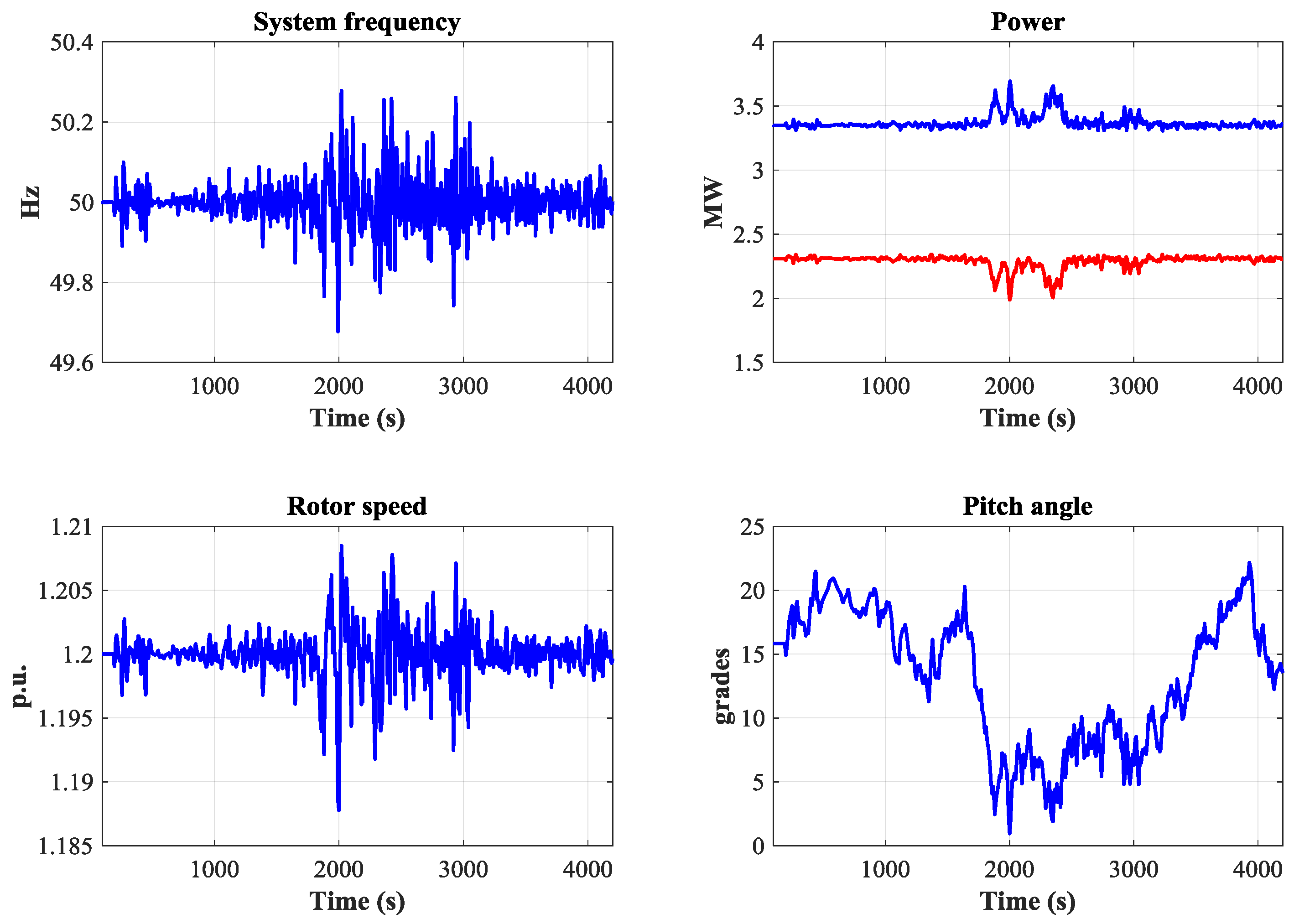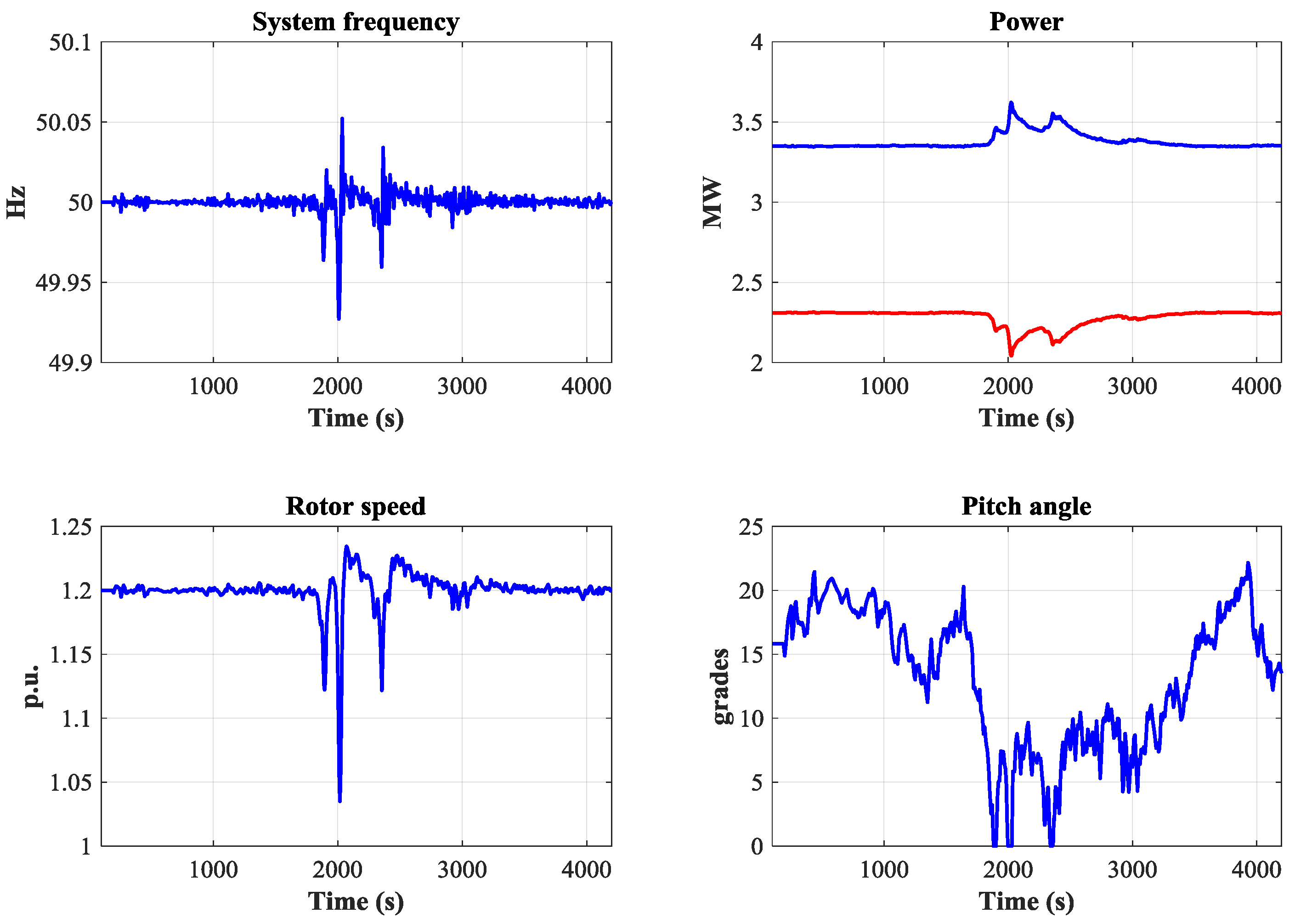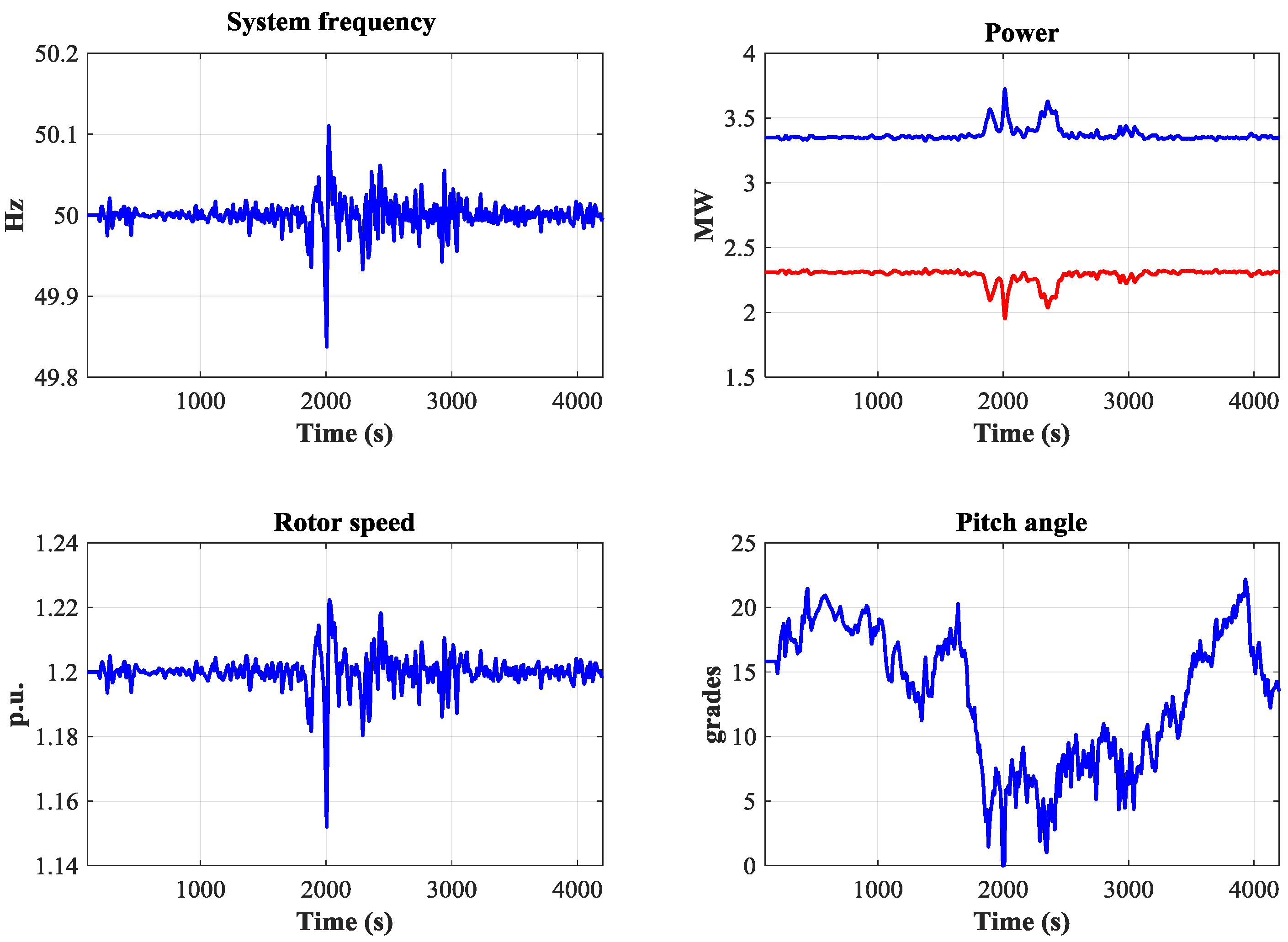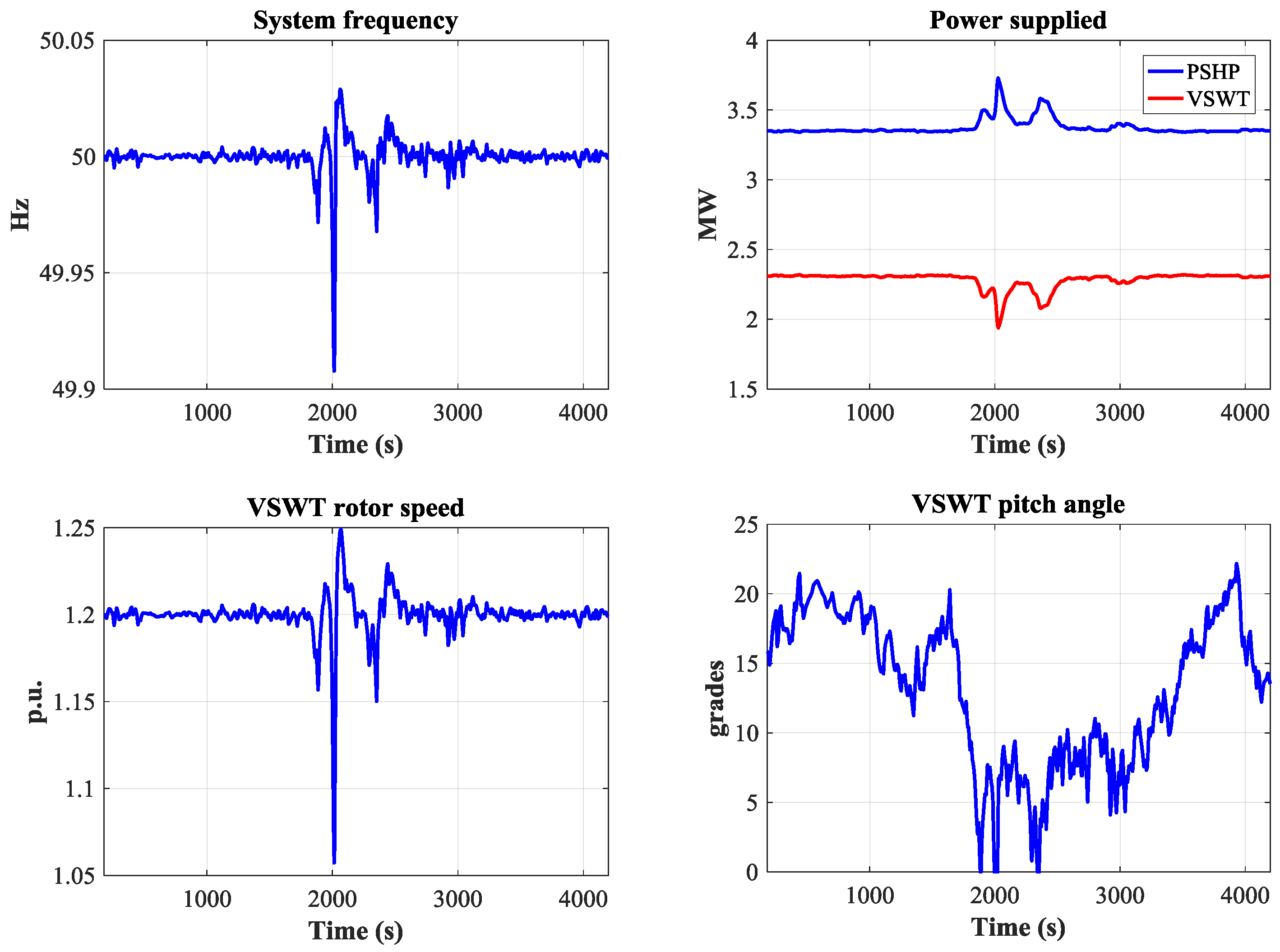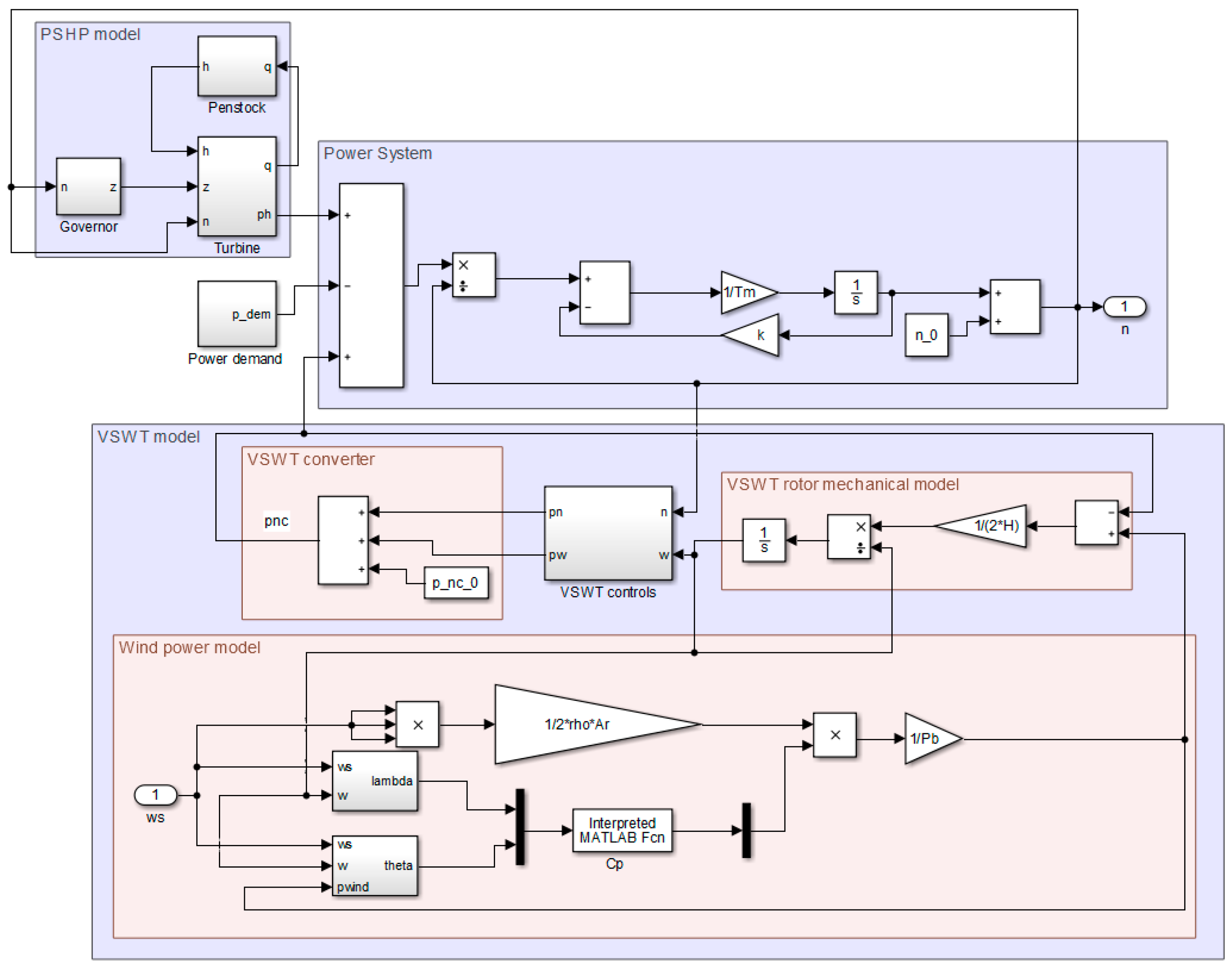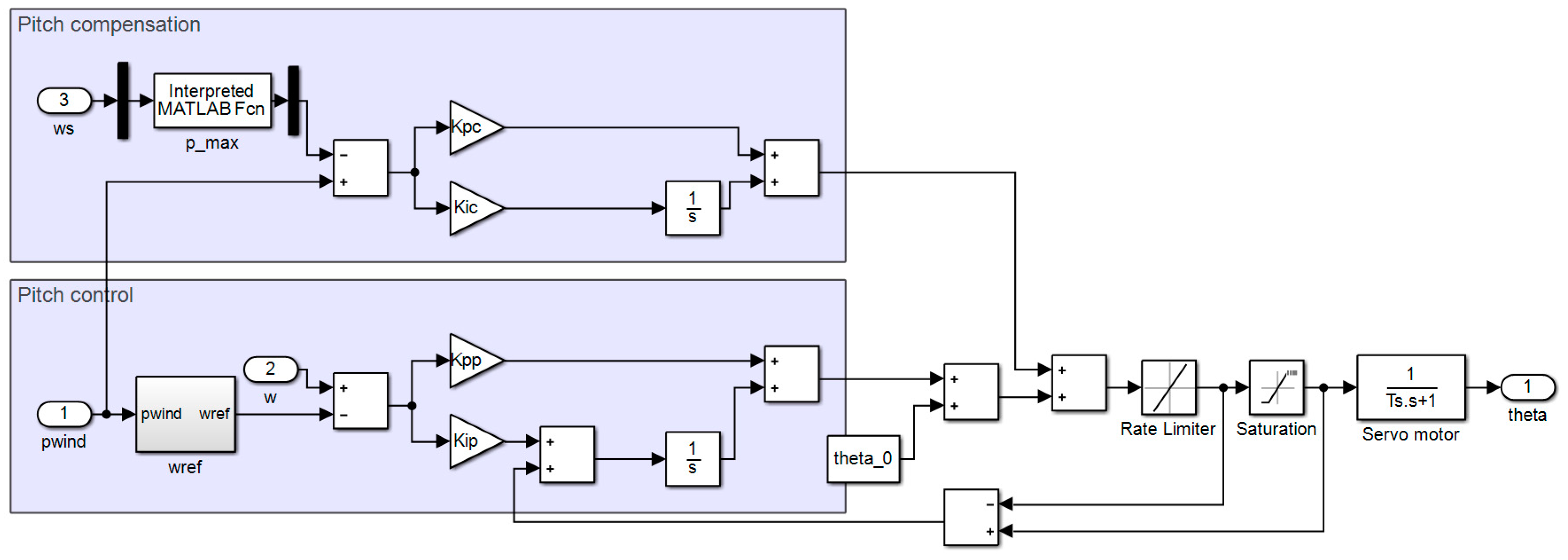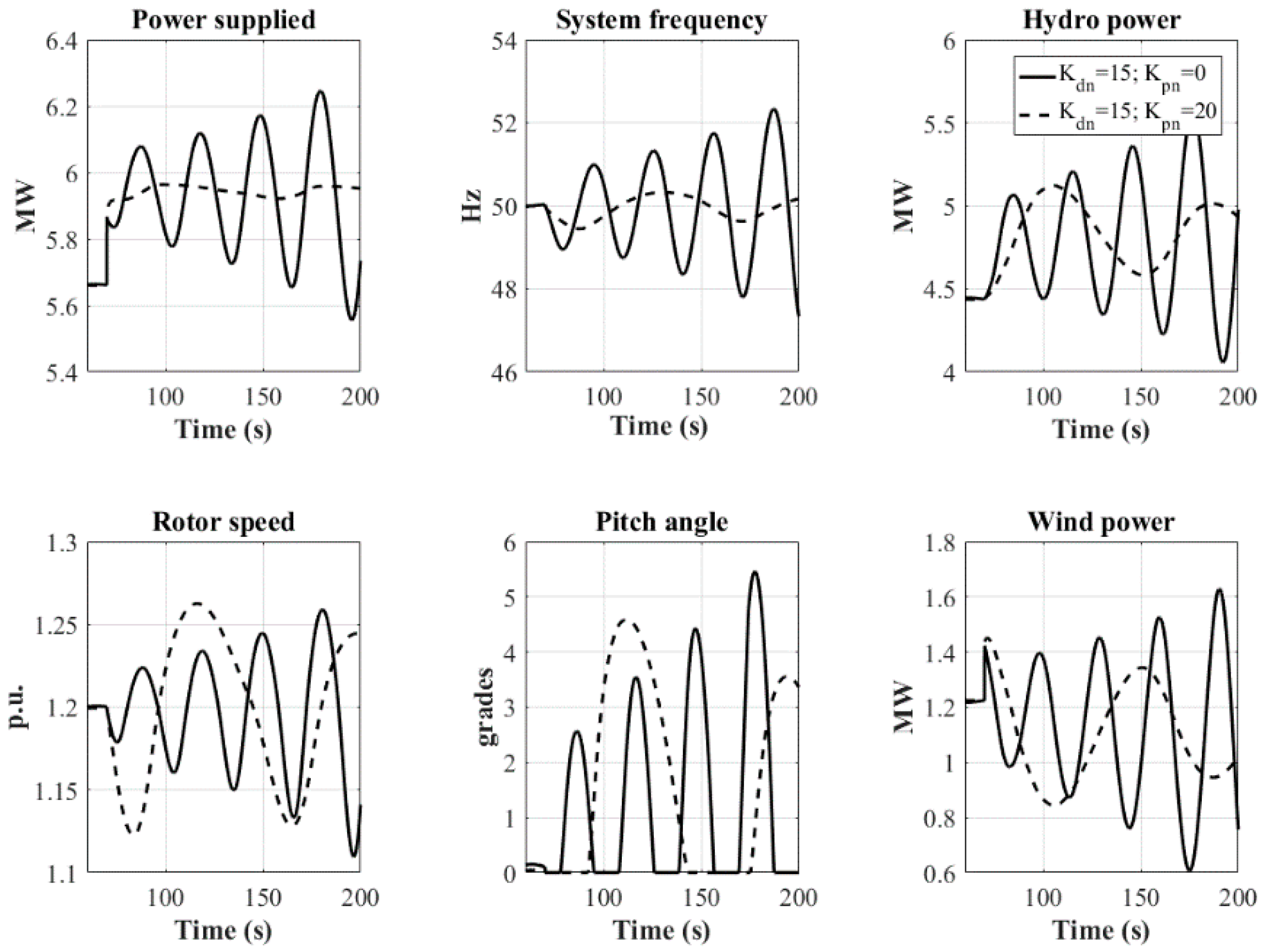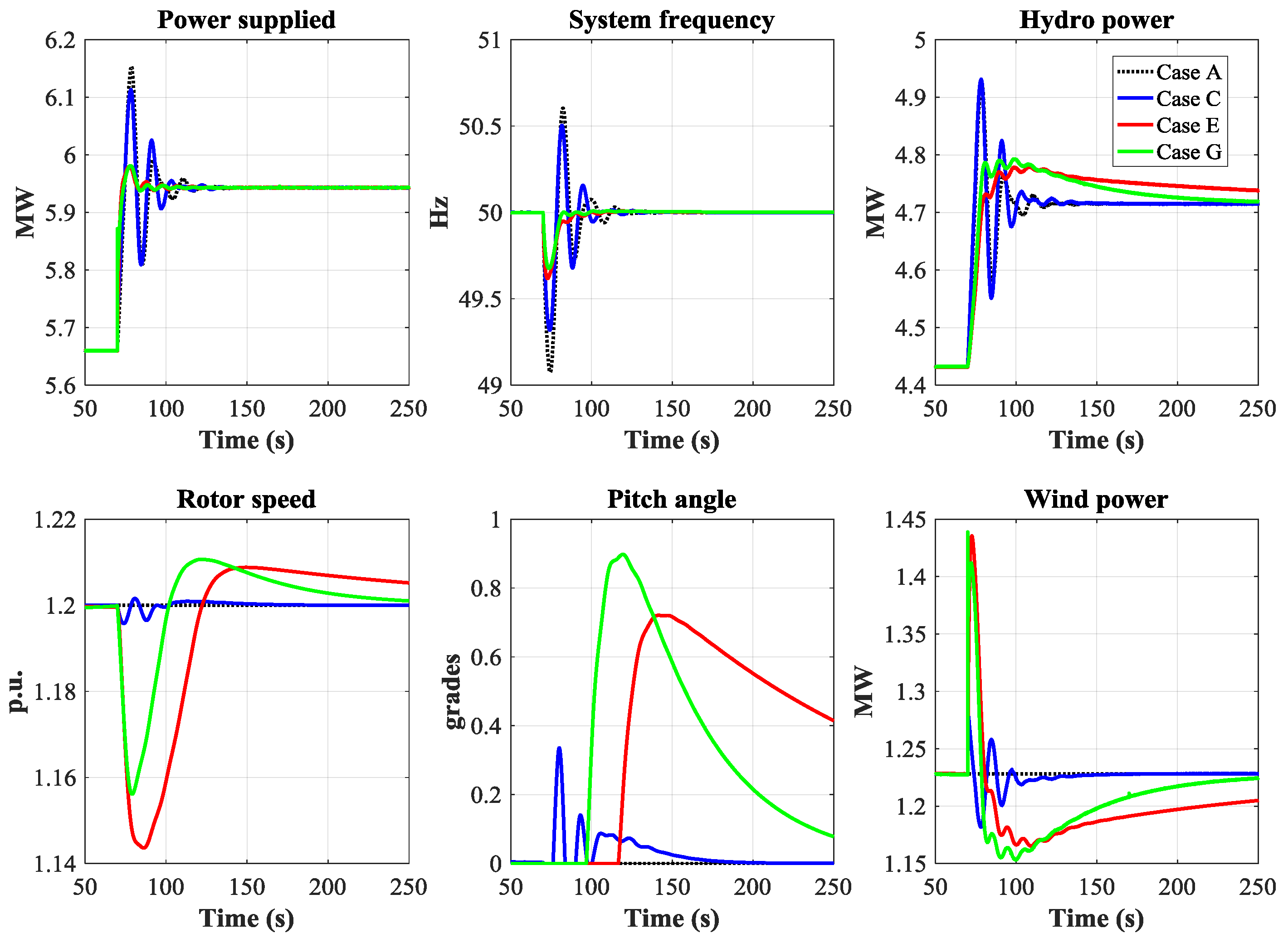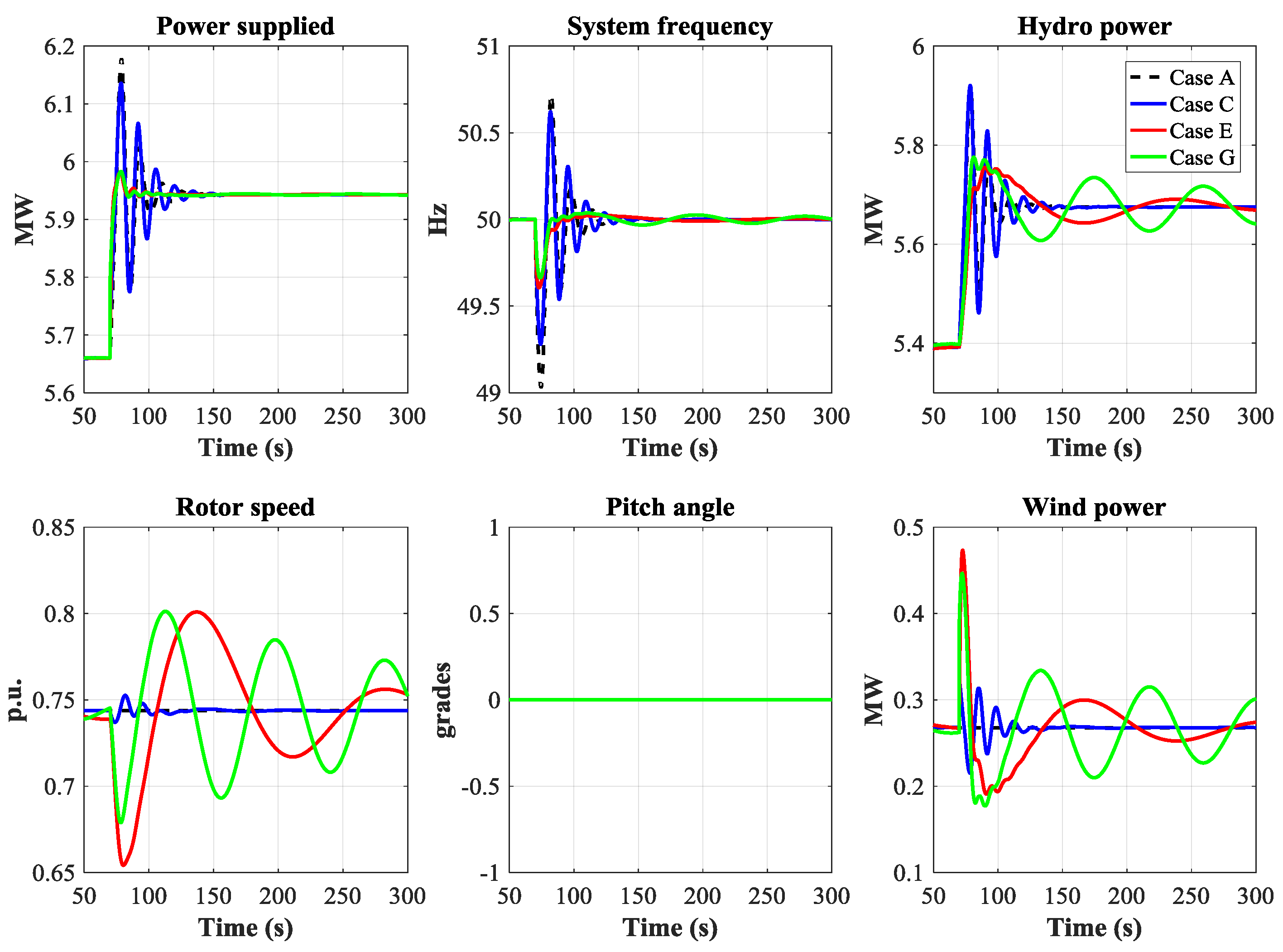1. Introduction
The increased use of intermittent renewable energy sources in most electric power systems has been documented [
1,
2]. These increases constitute a good way to reduce polluting gases generated by fossil fuel combustion. However, this class of renewable energies involves inherent drawbacks, such as unpredictability [
3] or demand independence [
4]. These characteristics of renewable sources negatively affect the quality of the supplied electrical energy, causing frequency [
5] and power disturbances [
6].
According to Albadi and El-Saadany [
3], the impact of renewable energies on power systems depends mainly on its penetration rate and the system inertia. For this reason, the negative effects of renewable energy sources are amplified in isolated systems. Nevertheless, in islands with wind potential, the economic and environmental costs of fossil fuels can be reduced. Therefore, the reduced use of fossil fuels owing to the increasing use of renewable energies in small isolated systems has become the main focus of numerous researchers during the past few years [
7,
8,
9,
10]. For example, Kaneshiro [
11] has analyzed how wind ramps affect the quality of supply in a Hawaiian power system, considering different rates of renewable penetration and highlighting the importance of wind forecasting in the medium and long term in order to operate the system safely and efficiently. In [
12], the penetration of wind energy in Flores Island has been shown to be limited because of low-frequency problems. According to [
13], the increased penetration of wind and solar energy in the power systems of the French islands of Martinique and Réunion has generated serious problems of frequency deviations, thereby establishing load shedding operations as common operations for all these power systems. In fact, the French government—by ministerial order—has limited the penetration of renewable sources in power systems to 30%.
Different methods exist in the literature that mitigate these negative effects. In [
6], a penalty system has been introduced for generators that cause frequency disturbances. Energy storage can contribute to this aim. Others [
14,
15] have carried out exhaustive reviews of available energy storage technologies in the last few years, remarking on the importance of pump storage hydropower plants (PSHP), flywheels, batteries, capacitors, or superconductors. Specifically, in the case of isolated systems, it has been shown that the long-term variability of renewable energy is well managed by combining wind and solar farms with PSHPs [
16,
17,
18]. However, in the short term, PSHPs need complementary technologies capable of injecting or absorbing power over brief time periods of a few seconds to avoid inadmissible frequency variations [
15,
19,
20]. These contributions to frequency regulations can be provided by flywheels [
21,
22], variable-speed hydro-pump turbines [
23], and others.
Variable-speed wind turbines (VSWT) can also provide frequency regulation to mitigate large frequency deviations after disturbances [
24]. Several approaches can be found in the literature on the contributions of frequency support to the regulation of wind turbines [
25,
26]. In general, VSWT provide negligible inertia since the fast control of power electronic converters maintains a practically constant output power irrespective of changes in the frequency of the grid [
27]. However, it is possible to achieve short-term inertial responses from variable-speed wind turbines by modifying their control loops [
28,
29,
30,
31]. According to this idea, synthetic inertia of a VSWT is modeled in [
32], highlighting the important improvement in the minimum frequency (NADIR). Different activation schemes for the synthetic inertia on VSWT based on full converters have been proposed in [
33]. The same authors have established the practical limits of synthetic inertial gains in the inertia controller used in full-converter VSWT generators in [
34].
Primary frequency regulation can also be provided by VSWT. The primary frequency response stabilizes the frequency at a new value by modifying the power generation proportionally to different frequency variations. Admittedly, a non-optimal working point can be reached in the response curve of torque and rotor speed of the turbine [
35,
36]. Furthermore, the impact of using doubly fed induction wind generators participating in primary frequency regulation has been evaluated in [
37,
38,
39]. Moreover, primary frequency regulation can be combined with inertia emulation [
40,
41]. In [
42], a control loop acting on the frequency deviation is added to the inertia emulation loop in order to enhance the inertia support from the wind turbine, maintaining a permanent frequency error.
The main problem of the contribution of VSWT to the primary regulation is that VSWT do not operate at their optimum operational point. This non-optimal operation would reduce the generated energy to some extent, and inevitably leads to economic losses [
43]. To mitigate this drawback, Mauricio et al. [
44] have presented a new method to improve the use of variable-speed wind energy conversion systems by modifying the inertial control scheme through the addition of a proportional loop that weights the frequency deviation. Both classical and modified inertial control loops allow the release of the stored fraction of the kinetic energy in rotational masses to provide earlier frequency support, thereby taking advantage of the fast response capability of electronically controlled converters. This control strategy does not need to have a regulation reserve, and thus allows a better use of wind resources.
The aim of this study is to evaluate the VSWT contribution to frequency regulation in an isolated power system when it operates solely based on the use of wind and hydro resources. Different control strategies for the VSWT are analyzed: inertial, proportional, and their combination. Primary regulation is not considered adequate in avoiding the negative economic effects associated with VSWT. The VSWT controller gains that have been proposed in the literature have been previously employed in interconnected systems, but these settings may not be adequate for isolated systems. Therefore, new controller adjustments will be used herein for each control strategy based on an exhaustive search. Additionally, this study has also analyzed whether it is necessary to modify the PSHP governor settings owing to the VSWT contribution to frequency regulation.
To achieve these objectives, a dynamic model has been developed. The construction of a realistic model that takes into account all the phenomena involved in system operations is essential in order to draw relevant conclusions [
45]. The PSHP configuration includes a large penstock, thereby limiting the applicability of rigid-water column models, and making it necessary to consider elastic phenomena [
46]. In order to model the VSWT properly, the VSWT speed governor, VSWT inertial control loop, VSWT blade pitch angle control, and VSWT aerodynamics, have been used.
Control strategies and adjustment methodology extracted from this study are applied to the El Hierro power system. El Hierro is an island in the Canary island archipelago. Historically, electric generation was based on diesel generators. The island aims to become entirely free from carbon dioxide emissions [
9]. In order to contribute to the achievement of this objective, a power hybrid wind–pumped storage hydropower plant (W-PSHP) at a rated power of 22.8 MW was committed in June 2014 to minimize utilization of fossil fuels [
47]. As a matter of fact, the electrical energy generated in 2015 by the W-PSHP in Gorona del Viento was 9 GWh, which corresponded to 22.5% of the total electrical energy demand in the island. During 2015, the maximum power demand was 7.7 MW. In fact, only just 1000 h of operation have been achieved since the onset of 100% renewable generation [
48]. This underutilization of renewable resources may have been caused by inadmissible frequency deviations. Although the inertia and the regulation capacity of PSHP are insufficient to elicit adequate responses to the fluctuations in demand and wind generation, the regulation capacity of the VSWT is currently not used. It is expected that frequency deviations will be reduced owing to the contribution of VSWT to frequency regulation, thereby approaching the fulfilment of the objective of operating the island with 100% renewable energy.
The paper is organized as follows. In
Section 2, the W-PSHP dynamic model is presented. The VSWT control loops and the control strategy are described in
Section 3. The methodology used to adjust the VSWT control loop gains based on an exhaustive search is proposed in
Section 4. In
Section 5, some realistic events applied to El Hierro power system are proposed to simulate the W-PSHP dynamic response so as to evaluate the proposed methodology. Finally,
Section 6 outlines the main conclusions of this study.
4. Controllers Adjustment Methodology
A methodology based on exhaustive searches is proposed for the adjustment of the PSHP and VSWT controller gains for each of the strategies described above. The benefits of the adjustments of the PSHP and VSWT controllers used together or individually were also analyzed. To achieve these strategies, two cases were considered: (1) known gains for the PSHP controller were assumed, and the gains of the VSWT controllers were then obtained, and (2) a search was conducted for all the controller gains. In order to obtain the PSHP governor gains and assess the contribution of the VSWT regulation, a strategy was considered in which VSWT did not provide frequency regulation, classified under ‘case A’.
Blade pitch angle variations are slow enough to be decoupled from the dynamic responses of other variables. In the literature, there is agreement on the value of these gains. Therefore, gains proposed in [
56,
57] have been assumed. Blade pitch angle control parameters are summarized in
Table A2 in
Appendix A.
Taking into account the casuistry described previously, seven different cases for the exhaustive searches are distinguished. These cases are summarized in
Table 1.
For cases B, D, and F, the PSHP governor gains obtained in case A were assumed. To obtain PSHP governor gains and VSWT controller gains for the cases described previously, several exhaustive searches had been carried out by varying the PSHP and VSWT controller gains when a 5% step increase in the load of the island had been simulated, according to the recommendation in [
62] for the speed governor of hydraulic turbines.
For each studied case, at least two different wind speeds should be considered for the exhaustive search representing high and low wind speeds, thus assessing the VSWT operating point influence on the adjustment of the controllers. Gains bounds are summarized in
Table 2. It was assumed that one equivalent turbine and one VSWT were operating. It has been verified that gains outside of these bounds can destabilize the system.
NADIR, the settling power time, or settling frequency time, are technical indicators that are used to define the system’s warranted frequency operating region from the unwarranted when an instant variance in the power demand takes place. These frequency response indicators can be used in any network to assess the frequency response owing to a loss of a generator [
63]. In this case, the settling frequency time (
Tn) is defined as the time it takes for the frequency to lie within the normal limits established by the Transmission System Operator (TSO) for isolated systems [
64]. The settling power time (
Tp) is defined as the time it takes for the power supplied by the VSWT and PSHP to be within ±2% of the power demand value.
It is difficult to find a group of controller gains that jointly provide the best values for these indicators. In the effort to achieve a compromising solution that improves these quality indicators, a coefficient has been proposed that favored increased NADIR values and penalized increased values for both settling times. This coefficient is expressed in accordance with Equation (19):
Therefore, NADIR, frequency settling time, power settling time, and the coefficient φ are used to characterise the quality of the system’s response. Adjustment criterion is defined as that aimed to extract the VSWT and PSHP controller gains based on the exhaustive searches, thereby yielding the best value of the coefficient φ.
5. Simulations and Results
Control strategies and adjustment methodology extracted from this study are applied to the El Hierro power system.
5.1. Case Study: El Hierro Power System
El Hierro is an island in the Canary island archipelago that was declared a biosphere reserve by United Nations Educational, Scientific and Cultural Organization (UNESCO). The island aims to become 100% free from carbon dioxide emissions [
9]. The electrical capacity of the island is 35.9 MW, contributed by diesel generators (13 MW), solar farms (0.03 MW), and a W-PSHP rated at a power of 22.8 MW. The PSHP generates 11.32 MW, and the five VSWT provide the remaining 11.48 MW [
65]. The electrical energy generated in 2015 by the Gorona del Viento W-PSHP was 9 GWh. This corresponded to 22.5% of the total electrical energy demand of the island. The maximum peak demand in that year was 7.7 MW, while the minimum was approximately 4 MW [
66]. Nowadays, only 1000 h of plant operation have been achieved since the onset of power generation using 100% renewable sources in June 2014 [
48]. Currently, the VSWT are not assigned to contribute to frequency regulation. Therefore, as the PSHP inertia and regulation capacity are insufficient to respond to the power demand and wind power fluctuations, a contribution from diesel generators is required to achieve frequency regulation. It is expected that the percentage of demand supplied by renewable resources will be increased. Thus, the number of hours of operation required to establish the island as self-sufficient based on the use of 100% renewable sources may be increased proportionally. In this context, it is assumed that the W-PSHP operates in isolation. Therefore, variations in power demand and wind power fluctuations are balanced by the VSWT itself and by the operation of the PSHP.
Data from the W-PSHP in Gorona del Viento used in the model have been obtained from [
58,
67,
68]. They are summarized in
Table 3.
5.2. Adjustment of Control Strategies
Prior to checking the adequacy of the proposed methodology, it has been proven that the VSWT controller gains proposed in [
44] for interconnected systems are not adequate for an isolated system, as shown in
Figure 6, since isolated systems are more sensitive to power disturbances than interconnected systems.
Table 4 list the results of the exhaustive searches and response indicators for all the cases proposed previously for representative wind speeds of 10 m/s and 20 m/s, when a 5% power demand step is imposed.
Case A, in which the VSWT does not provide frequency regulation, is similar to the strategy proposed in [
55]. It has been proven that the PSHP governor gains proposed by the authors, and the gains obtained in this study, match closely.
Figure 7 shows the comparison of the quality indicators between the seven proposed cases. It can be observed that the fast frequency response elicited by the proportional controller improves the NADIR value, thereby reaching an even better value when it acts synergistically with inertial control. In the same way, the power settling time is reduced. To reduce the frequency settling time, it is convenient that both controls act jointly. In contrast, if only the inertial control is effective, the frequency settling time is increased.
Although the proposed criterion does not aim towards the improvement of any particular quality indicator, the three previously mentioned are improved. It is important to highlight the system’s improvement by obtaining the set of gains jointly (PSHP + VSWT) rather than individually (VSWT), comparing elicited results from cases C, E, and G, compared to B, D, and F, respectively. Finally, the need to take into account the wind speed is verified since the latter determines the operating point of the VSWT, and therefore the operating point of the PSHP. Once the wind speed has been taken into account in the setting of the controllers, it will not significantly affect the quality of the power system.
5.3. Simulation Results
To check the suitability of controller adjustments, Jones et al. [
69] affirmed that it is enough to simulate a step, a ramp, and a random signal. In accordance to this methodology, three different events related with renewable sources generation were simulated in [
70]. Therefore, a load step, a wind-speed ramp (see
Figure 8a) and a wind-speed fluctuation (see
Figure 8b) have been simulated. Notwithstanding, unfortunately, these results cannot be compared at the present time with experimental data, it seems reasonable to expect a fairly good agreement, because a similar model has been used in [
45] for Dinorwig power plant, where the simulation results reproduce the field measurements with sufficient accuracy.
Cases from B to G have been compared with case A, and have been considered as the base case to highlight the variation of each parameter mentioned previously. For case A, simulations with variable wind speeds, and gains
Kpw and
Kiw have been extracted from [
44] and assigned to 1.5 and 0.15, respectively, since they could not be extracted from the exhaustive search.
Figure 9 and
Figure 10 show the dynamic response comparison between the base case (case A) and the different cases of VSWT contributions to frequency regulation, when a 5% power demand step is imposed, considering constant wind speeds of 10 m/s and 20 m/s, respectively, and for the cases in which PSHP and VSWT controller gains have been obtained jointly.
It can be verified that, regardless of the wind speed, the contribution of the VSWT to the frequency regulation is positive for the system, since it increases the value of the NADIR reducing the frequency and power settling time. In addition, VSWT contribution moderates the PSHP mechanical equipment movements.
Additionally,
Figure 11 also shows the dynamic response comparison between the base case (case A) and the different cases of VSWT contributions to frequency regulation, when a 5% power demand step is imposed, considering constant wind speed of 6 m/s and for the cases in which PSHP and VSWT controller gains have been obtained jointly. In this low wind speed regime, the blade pitch control does not act and the rotor speed variances are only controlled by changing generator torque. Despite the low power generated by the VSWT due to the low wind speed, the VSWT can still contribute to the frequency regulation by improving all the mentioned system quality indicators. However, as can be seen in the simulation, proportional control makes the rotor speed would take too long to recover its reference speed after the disturbance. Nevertheless, inertial control can improve the system dynamics without compromising the stability of VSWT.
Figure 12 shows the comparison of the dynamic responses of the system between the strategy in which VSWT did not contribute to the regulation, and the various other strategies of contribution in instances when a linear wind speed variation takes place.
Table 5 summarizes the medium-frequency deviation for each strategy, calculated based on Equation (20), NADIR, maximum frequency peak, nozzle movements per second, and blade angle movements per second when a wind ramp is simulated.
As shown in
Figure 12, when a wind speed ramp takes place, and frequency regulation is only provided by the PSHP (case A), the frequency attains values outside the limits established by the TSO (50 Hz ± 0.15 Hz) [
64]. In addition, the medium frequency deviation, NADIR, maximum frequency peak, and nozzle movement values are improved, supposing a small increase in the movements of the VSWT blades.
The elicited results from the simulation of a wind speed fluctuation are summarized in
Table 6, listing for each strategy the wind energy generated, medium frequency deviation, NADIR, maximum frequency peak, nozzle movements per second, and blade angle movements per second. Moreover,
Figure 13 shows the frequency comparison between cases A, C, E, and G. In addition, the dynamic responses of the system in cases A, C, E, and G during the wind speed fluctuation are shown in
Appendix B.
As seen in
Table 6, the VSWT contribution to frequency regulation implies a negligible loss of wind energy (less than 0.25%). Nevertheless, the medium frequency deviation, NADIR, maximum frequency peak and nozzle movement values are improved.
In both simulations assuming variances in wind speed, it is verified that for the proposed cases, the VSWT contribution to frequency regulation implies an improvement in the frequency indicators of the quality system. In regard to the moving parts, an important reduction in the movements of the turbine nozzle (more than 80%) takes place, thereby increasing its remaining lifetime. These reductions in movements suppose a small increase (less than 10%) in the movements of the VSWT blades. It can be observed that emulation of inertia improves the minimum and maximum frequency peaks as well as the medium frequency deviation in a better manner compared to proportional control. More importantly, these indicators reach an even better value when proportional control acts together with inertial control. The system improvement is also evaluated by obtaining the set of combined gains (PSHP + VSWT) instead of individually gains when wind variation is simulated comparing results from cases C, E, and G, to those from B, D, and F, respectively, in both simulations assuming variances in wind speed.
6. Conclusions
In this study, the capacity of a hybrid wind–hydro power plant to contribute to frequency regulation in an isolated system has been evaluated. To achieve this, a PSHP operating in generation mode, and VSWT connected to an isolated system, have been modeled.
In addition to the frequency regulation, usually provided by the hydroelectric power plant, VSWT can contribute to frequency regulation according to different proposed control strategies, including inertial, proportional, and their combination. To the author’s knowledge, there is no control strategies for VSWT to contribute to frequency regulation in conjunction with a hydroelectric plant in an isolated system proposed previously. It has been proven that VSWT controller gains recommended for interconnected systems are not adequate for isolated systems, since isolated systems are more sensitive to power disturbances than interconnected systems. Therefore, a methodology based on exhaustive searches for the set of gains for the PSHP and VSWT controllers has been conducted according to a proposed criterion. The convenience of adjusting jointly PSHP and VSWT regulators and taking into account the wind speed regime has been demonstrated.
Control strategies and adjustment methodology extracted from this study have been applied to the El Hierro power system, evaluating by simulating different events related to fluctuations in wind speed, or variations in power demand. Considerable improvements concerning frequency deviations have been achieved. When a load step occurs, the fast frequency response provided by the proportional controller improves the NADIR value, thereby reaching an even better value when it acts synergistically with inertial control. Nevertheless, inertial control improves the minimum and maximum frequency peaks as well as the medium frequency deviation in a better manner compared to proportional control when wind speed variations are simulated. For both disturbances, better quality indicators were achieved even when proportional control acted together with the inertial control. In addition, wind energy lost owing to the VSWT contribution to frequency regulation could be considered negligible.
Moreover, a simulation with a low wind speed has been carried out. In this speed regime, the blade pitch control does not act and the rotor speed variances are only controlled by changing generator torque. It has been proved that proportional control can destabilize the VSWT. Nevertheless, inertial control can improve the system dynamics without compromising the stability of VSWT.
Finally, it has been verified that the VSWT contribution to frequency regulation improves the lifetime of the hydro turbine governing system owing to the reduction of their movements at the expense of an admissible and increased workload imposed on the wind turbine blades.
